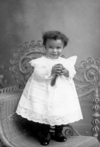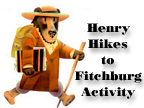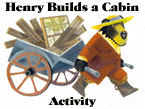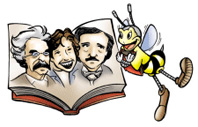

| National Content Standards Below is a selected list of English Language Arts and Technology content standards that reflect the general focus of this article. Additional standards may be applied depending on the lesson and specific benchmarks. English Language Arts National Standards 1. Students read a wide range of print and non-print texts to build
an understanding of texts, of themselves, and of the cultures of
the United States and the world; to acquire new information; to respond
to the needs and demands of society and the workplace; and for personal
fulfillment. Among these texts are fiction and nonfiction, classic
and contemporary works. 3. Students apply a wide range of strategies to comprehend, interpret, evaluate, and appreciate texts. They draw on their prior experience, their interactions with other readers and writers, their knowledge of word meaning and of other texts, their word identification strategies, and their understanding of textual features (e.g., sound-letter correspondence, sentence structure, context, graphics). 6. Students apply knowledge of language structure, language conventions (e.g., spelling and punctuation), media techniques, figurative language, and genre to create, critique, and discuss print and nonprint texts. 8. Students use a variety of technological and information resources (e.g., libraries, databases, computer networks, video) to gather and synthesize information and to create and communicate knowledge. 10. Students whose first language is not English make use of their first language to develop competency in the English language arts and to develop understanding of content across the curriculum. 11. Students participate as knowledgeable, reflective, creative,
and critical members of a variety of literacy communities. Technology Standards (ISTE) 3. Technology productivity tools • Students
use technology tools to enhance learning, increase productivity,
and promote creativity. 4. Technology communications tools • Students
use telecommunications to collaborate, publish, and interact with
peers, experts, and
other audiences. |
Reading Reconnaissance
Finding just the right book that will grab a student’s interest is like looking for Waldo. Tracking down books that correlate with specific curriculum areas and topics for study can be daunting. What is a library media specialist to do? Use every tool in your arsenal as well as lessons and booklists that have already been prepared and just waiting to be uncovered by the savvy searcher. This collection of Websites will serve as starting points in your quest to recommend the best books to meet the needs of students and teachers. Reading Booklists and Lessons Integrate art into a host of curriculum areas, including language arts. Click on Lessons under the Teach heading. Then, conduct a search by selecting the art topic, additional subject area, and grade level. Choosing music, language arts, and grades 5-8, returned lessons such as Civil War music, Little Women, and Set a Poem to Music. Additional links provide connections to teaching strategies ways to participant in community cultural events. Search or browse over a hundred outstanding lessons that encourage students to actively read and write. For instance, high school students might analyze poetic devices in Robert Hayden’s Those Winter Sundays. Elementary students might compare the plot and setting characteristics in several versions of Cinderella. Numerous reviewed Websites augment each lesson. EDSITEment is a partnership among the National Endowment for the Humanities, Verizon Foundation, and the National Trust for the Humanities. Get Ready, Set, and Go directly to this site for lessons that can be selected by grade band, literacy strand or literacy engagement. Each lesson follows the IRA/NCTE Standards for the English Language Arts and includes student-ready materials such as worksheets, interactive tools, and reviewed Web resources. Students will love the interactive tools and so will teachers. From creating and printing book covers to writing fractured fairy tales, the process is quite easy. Students to fill-in the blanks, draw pictures, and print their work. This site is highly recommended for its stands-based emphasis and simple navigation. Looking for short biographies of authors, need a discussion guide, or want ideas for book talks, then head to Scholastic’s Website for librarians. Sign up for monthly email about new releases. Learn the step-by-step process for inviting authors to your school. Introduce elementary students to the Flashlight Readers Club where kids can explore books, connect with authors, and participate in activities. The Teacher Book Wizard allows teachers to match the right books from a multitude of publishers to their students’ interests. Vandergrift’s Special Interest Site Vandergrift provides dozens of references to biographies about authors and illustrators. Many thoughtful ideas about children’s literature are presented through her scholarly work. She also delves into sensitive issues such as coming of age, gender, and culture that are relevant to today’s youth. A bibliography of books is listed under each topic. Reading and Writing Activities You will find well over 15,000+ worksheets that are free to use for educational purposes. Choose a main topic to begin viewing our worksheets. Absolutely a tgerric site This pre-school Library is full of great activities for you to explore. Story Place is published by the Public Library of Charlotte and Mecklenburg County North Carolina. Introduce younger students to a place where they can share their book reports with other readers in a safe environment. All of the reports are vetted before publication and no student data is collected. The tool for writing a report employs java technology so make sure the Web browser is compatible. Begin by answering questions about the book such as title, author, publisher, and genre. Next, write a review and insert an image. Finally, rate the book and submit the report. A password is provided for each report for future edits. Reports can be searched by author, title, keyword, genre, reporter, and nationality. Rounding out the site are games and links to resources such as style guides and writing tutorials. International Children’s Digital Library When families move from one country to another, books in their native language are often left behind. The International Children's Digital Library (ICDL) is building a collection of books that represent outstanding historical and contemporary books from throughout the world. Currently there are over 2000 titles. Searching is easy. Categories are like the shelves in a regular library. Simply click on a button like fairy tales or red book and a list pops up on the screen. To narrow the search further, select a language. Teachers with ESL students may find this site useful. ReadPrint is a massive library of free online books that include authors such as Mark Twain, Stephen Crane, and H.G. Wells. Teachers and students can read biographical sketches of authors and search within their works. One section of the site is completely dedicated to Shakespeare. It's great source for research projects. The focus of Reading is Fundamental (RIF) is to develop children and family literacy programs. RIF offers scores of activities for readers of every age group and every skill level. Our activities provide solid learning opportunities through interaction with peers and siblings, and promote literacy through structured learning opportunities with parents. Best of all, they’re fun! Author Visits Authors and Illustrators Who Visit Schools Authors and Illustrators Who Visit Schools is a directory service that lists several authors and illustrators who will make a school visit. Useful information includes a photograph, awards, description of the program, fees, and how to contact the individual. This directory of authors and illustrators allows the visitor to
search by region or alphabetically. Each listing contains biographical
information, published books, description of the presentation(s),
audio-visual equipment, and the professional fee. A timely article,
Visit Guidelines, will help teachers and media specialists prepare
for the event. |
Children of YesterYear Writing Prompts Use primary source photographs to spark student writing. Each photograph has a title and a question. A photo analysis guide is included. Henry Hikes to Fitchburg by D. B. Johnson is a book for ages 4 to 104. It is based on Walden written by Henry David Thoreau, a writer, naturalist, and surveyor in the mid 1800s. In the book, Henry and his friend travel from Concord to Fitchburg, Massachusetts. Henry hikes the 30 miles while his friend works odd jobs for the train fare. Who arrives first? Read this delightful book, then choose your path to Fitchburg. Be sure to keep a journal of your activities. When Henry decides to build a cabin, he is given lots of advice from his friends. While others think it should be bigger, he has his own ideas. Follow Henry through the building process and see how his cabin is just right! Then, play the Build a Cabin game. Henry Builds a Cabin is another fantastic book by D.B. Johnson that looks at the life of Henry David Thoreau in a delightfully engaging way. It is a book for all ages. Send your students on an online author scavenger hunt. April Morning by Howard Fast is on many core reading lists and addresses several of the standards in reading/language arts as well as social studies. This lesson draws upon primary sources as a means to interpret the events of April 19, 1775.
|
||
|
||||
Updated June 7, 2023
© 1996 - 2015 Linda C. Joseph
All Rights Reserved
All CyberBee Graphics are Trademarked
Graphics by
Darlene Vanasco/Creative Director
Erika Taguchi/Designer & Illustrator
Hosting Provided by Iwaynet




